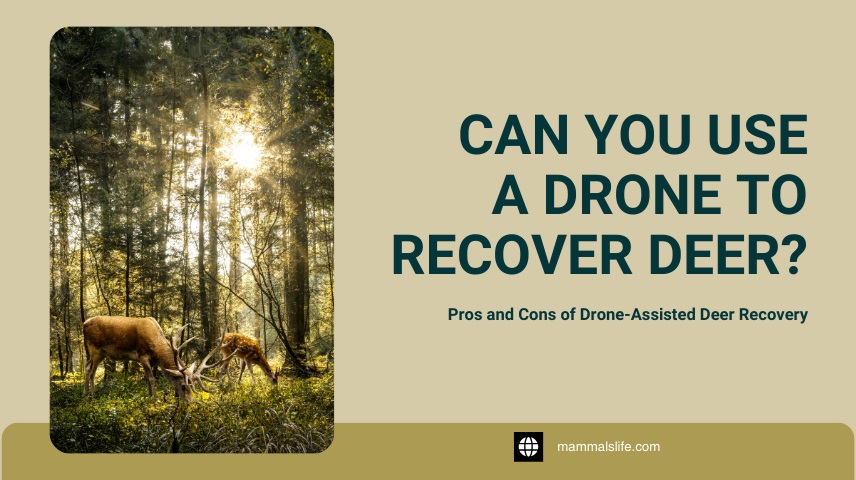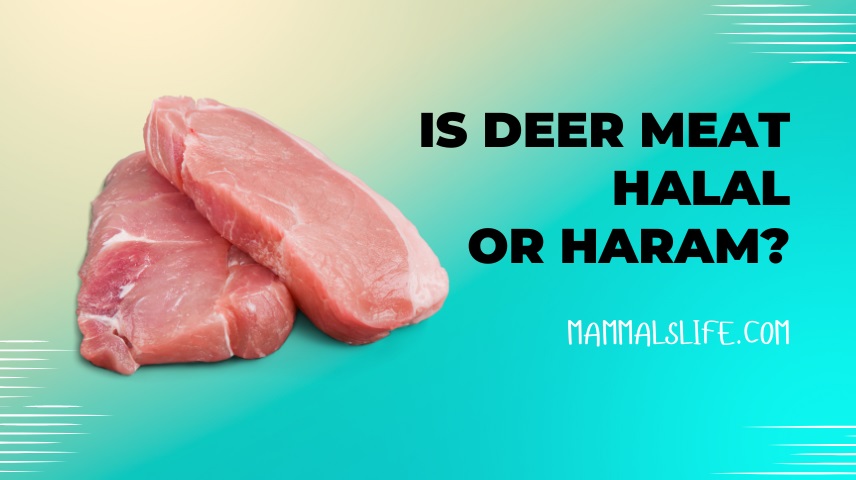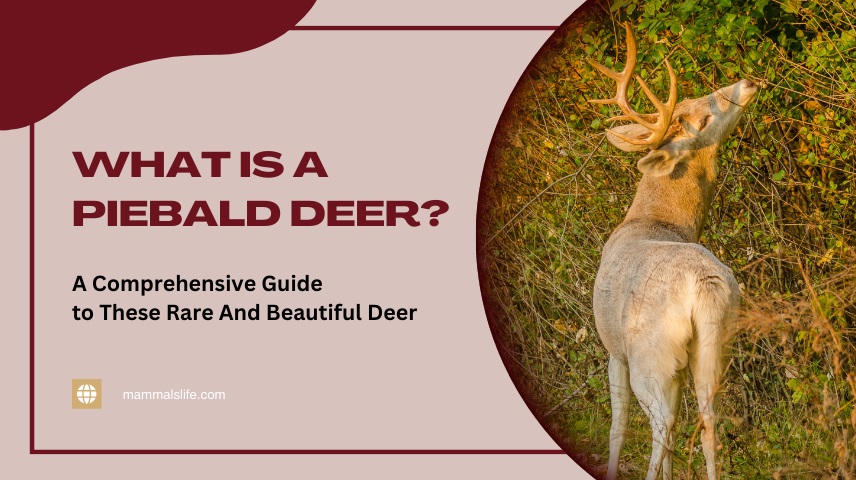Last Updated on February 22, 2025 by Mammals Life
Yes, you can use a drone to recover deer. Drones offer both advantages and disadvantages for deer recovery.
Drones have gained popularity for various applications, including wildlife management. Using drones to recover deer can be highly effective. They provide aerial views, making it easier to locate deer in dense forests or hard-to-reach areas. This technology saves time and reduces physical effort.
On the downside, drones can be noisy, potentially disturbing wildlife. Additionally, operating a drone requires skill and adherence to local regulations. While drones offer innovative solutions, their use in deer recovery must be carefully managed to balance benefits and drawbacks.
The Rise Of Drone Technology
Drones have become very popular in recent years. They are used in many fields. These flying devices help with tasks that were hard before. One such task is deer recovery.
Introduction To Drones
Drones are also called unmanned aerial vehicles (UAVs). They can fly without a pilot on board. People control them remotely. Some drones can even fly by themselves using smart software.
Modern drones come with cameras and sensors. These features make them useful in many ways. Drones can capture photos and videos from the sky. They can also detect heat and movement. This makes them very useful for wildlife tasks.
Applications In Wildlife
Drones help wildlife experts in many ways. They are used for tracking and monitoring animals. They also assist in counting animal populations. Drones help in mapping and studying animal habitats.
Drone technology is now used in deer recovery. Deer recovery is finding and retrieving deer. Hunters and wildlife managers find this very helpful.
| Pros of Drone-Assisted Deer Recovery | Cons of Drone-Assisted Deer Recovery |
|---|---|
|
|
Read More – Do Deer Mourn Their Dead? Examining the Evidence of Mourning in Wildlife
Drone-assisted Deer Recovery
Drone-assisted deer Recovery is a new method for hunters and wildlife enthusiasts. This approach uses drones to locate and recover deer. It offers several benefits but also has drawbacks.
Concept And Process
The concept of Drone-Assisted Deer Recovery involves using drones equipped with cameras. Hunters can survey large areas quickly. The process starts with the drone taking off and scanning the area. High-definition cameras capture live footage. Operators watch the screen to spot deer. Once a deer is found, the location is marked. This helps in quick and efficient recovery.
Additionally, drones can fly over difficult terrains. This means less physical effort for hunters. It also reduces the time spent in the field. Drones can cover more ground than humans on foot. This makes the recovery process faster and more efficient.
Technological Requirements
Using drones for deer recovery needs certain technological requirements. Firstly, a drone with a high-definition camera is essential. The camera should have good resolution for clear images. Night vision or thermal cameras are also beneficial. They help in low-light conditions.
Secondly, a reliable GPS is crucial. This helps in marking the exact location of the deer. Operators need a stable internet connection. This ensures smooth live streaming of footage. A good battery life is also important. It allows the drone to cover large areas without frequent recharges.
Here is a table summarizing the key technological requirements:
| Requirement | Description |
|---|---|
| High-Definition Camera | For clear and detailed images |
| Night Vision/Thermal Camera | For low-light conditions |
| Reliable GPS System | For smooth live-streaming |
| Stable Internet Connection | For smooth live streaming |
| Good Battery Life | For longer operational time |
These requirements ensure effective and efficient drone-assisted deer recovery. Having the right technology makes a significant difference.
Read More – Are Muntjac Deer Dangerous? What You Need to Know About Their Aggression
Advantages Of Using Drones
Drones are changing how hunters recover deer. They offer many benefits that make the process easier and faster. Below, we will discuss some key advantages.
Efficiency And Speed
Drones can cover large areas quickly. This saves hunters time and effort. They can locate deer faster than traditional methods. With a drone, you can scan fields and forests in minutes.
Using thermal cameras, drones detect heat signatures. This makes it easier to find deer, even in dense woods. The entire recovery process becomes more efficient.
Safety And Accessibility
Drones enhance safety by reducing physical risks. Hunters don’t have to traverse rough terrains. This minimizes the chance of injury.
They also improve accessibility. Drones can reach areas that are hard to access on foot. They can fly over rivers, ravines, and thick brush. This makes the search safer and more effective.
| Advantages | Description |
|---|---|
| Efficiency and Speed | Cover large areas quickly, detect heat signatures. |
| Safety and Accessibility | Cover large areas quickly, and detect heat signatures. |
Read More – Why Do Deer Stomp Their Feet? A Closer Look at Deer Warning Signals
Challenges And Limitations
Using drones for deer recovery offers many benefits. Yet, challenges and limitations exist. This section highlights the main issues with drone-assisted deer recovery.
Technical Issues
Drones can face many technical problems. These issues can hinder deer recovery efforts. Here are some common technical challenges:
- Battery Life: Drones have limited battery life. They need frequent charging.
- Signal Interference: Trees and hills can block the drone’s signal.
- Weather Conditions: Rain and wind can damage drones. They also affect flight stability.
- Camera Quality: Low-quality cameras may not spot deer. High-quality cameras are expensive.
Ethical Concerns
Using drones for deer recovery raises ethical questions. These concerns involve both the animals and the environment. Consider these points:
- Animal Stress: Drones can scare deer. This can cause stress and harm to the animals.
- Privacy Issues: Drones may invade private property. This raises privacy concerns.
- Wildlife Disturbance: Other wildlife can be disturbed by drones. This affects the natural balance.
In summary, while drones offer many benefits, they also come with significant challenges and limitations. These must be carefully considered for effective and ethical deer recovery.
Legal And Regulatory Aspects
Using drones for deer recovery is an exciting idea. But it’s crucial to understand the legal and regulatory aspects. These rules ensure the safety of both the animals and the environment. Different regions have different laws, and ignoring them can lead to fines or other penalties.
Permits And Licenses
Before using a drone, check if you need any permits or licenses. Some regions require specific permits for drone operations. This is especially true for areas with a lot of wildlife.
- Check local and state regulations.
- Apply for necessary permits if required.
- Always carry your permits while operating the drone.
Permits ensure you are operating within the law. They also help authorities monitor drone activities. This is important for keeping wildlife safe.
Wildlife Protection Laws
Wildlife protection laws are in place to protect animals from disturbance. Using drones could stress deer and other wildlife.
- Be aware of the laws protecting wildlife in your area.
- Follow guidelines to minimize disturbance.
- Respect protected areas where drones are not allowed.
Violating these laws can result in penalties. It can also harm the animals you aim to help. Always prioritize the well-being of the wildlife.
Future Of Drone-assisted Recovery
The future of drone-assisted deer recovery looks promising. Technological advancements are enhancing the capabilities of drones. This helps hunters and wildlife enthusiasts alike. The potential for drones in this field is vast. They could transform the way we track and recover deer.
Technological Innovations
Drones are becoming smarter and more efficient. New features are being added regularly. Here are some key innovations:
- Advanced cameras: Drones now have high-resolution cameras. These cameras provide clear images from high altitudes.
- Thermal imaging: This helps locate deer in dense forests. Thermal cameras detect heat signatures, making it easier to spot animals.
- Longer battery life: Modern drones can fly for longer periods. This allows for extended search times without frequent recharging.
- Autonomous navigation: Drones can now follow pre-set paths. This ensures thorough coverage of large areas.
Potential Expansions
The applications of drone technology in deer recovery are expanding. Here are some potential areas of growth:
| Application | Benefit |
|---|---|
| Real-time data analysis | Instant insights into deer movements and health. |
| Collaboration with wildlife agencies | Improved tracking of deer populations. |
| Integration with other technologies | Combining drones with GPS collars for better accuracy. |
| Enhanced safety features | Reducing risks for both drones and wildlife. |
Drones are not just for hobbyists anymore. They are becoming essential tools for wildlife management. As technology evolves, so will the use of drones in deer recovery.
Frequently Asked Questions
Why Can’t You Use A Drone To Recover A Deer?
Using a drone to recover a deer is illegal in many areas. Drones can disturb wildlife, causing stress. They may also violate hunting regulations.
What Drone Do They Use For Drone Deer Recovery?
Drone deer recovery often uses DJI Mavic 2 Enterprise drones. These drones have thermal imaging capabilities, making them ideal for locating deer efficiently.
What States Allow Drone Deer Recovery?
Currently, no states in the U. S. allow drone deer recovery. Regulations prohibit drone use for hunting or wildlife recovery. Always check local laws.
Can You Use A Drone To Recover A Deer In PA?
No, you cannot use a drone to recover a deer in Pennsylvania. It is illegal under state wildlife regulations.
Can Drones Legally Recover Deer?
Yes, legality varies by region. Check local wildlife regulations before using a drone for deer recovery.
Conclusion
Using drones for deer recovery has clear benefits and drawbacks. They offer efficiency and advanced tracking capabilities. However, ethical concerns and legal restrictions may limit their use. Carefully weigh these factors before deciding. Embrace technology responsibly to ensure a balance between innovation and wildlife conservation.











